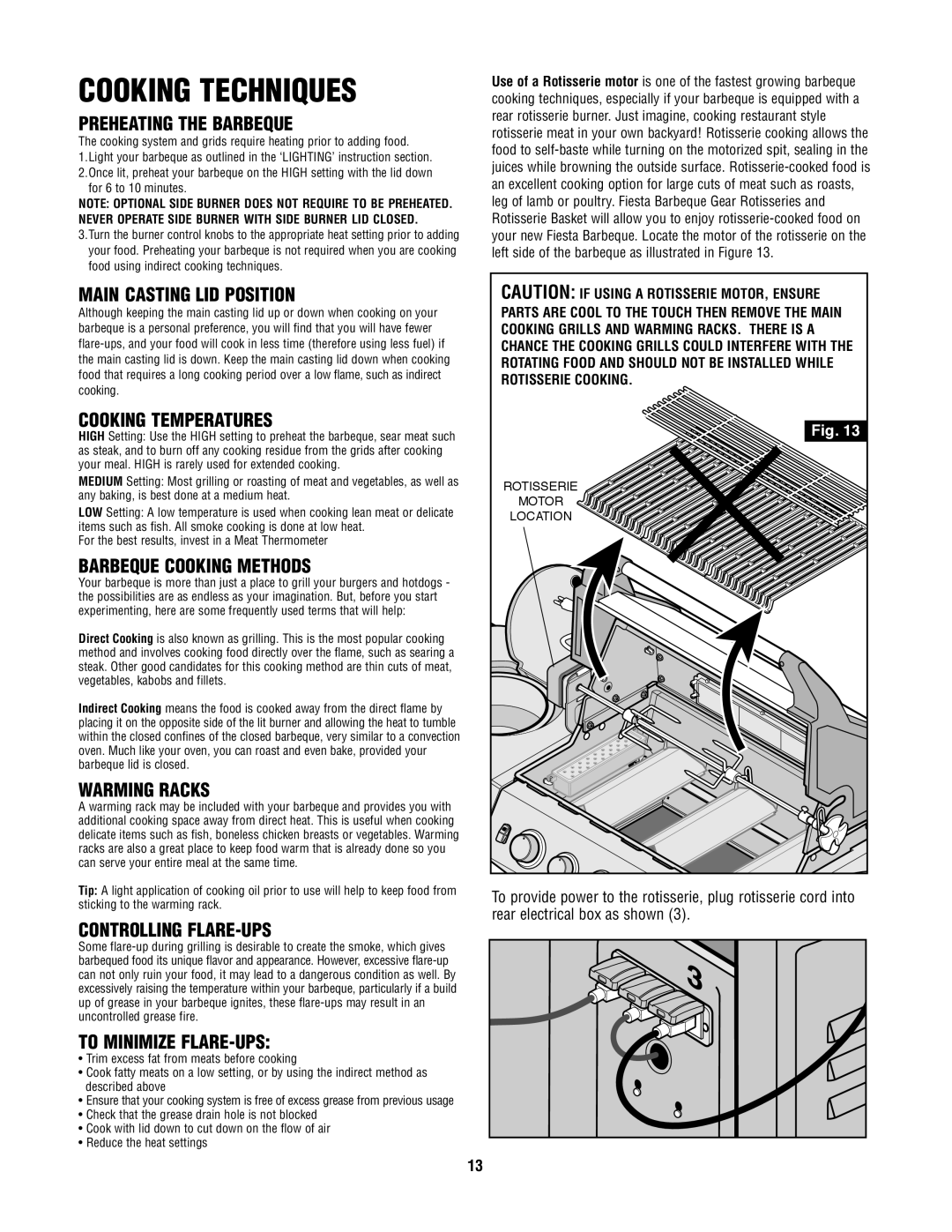
COOKING TECHNIQUES
PREHEATING THE BARBEQUE
The cooking system and grids require heating prior to adding food. 1.Light your barbeque as outlined in the ‘LIGHTING’ instruction section. 2.Once lit, preheat your barbeque on the HIGH setting with the lid down
for 6 to 10 minutes.
NOTE: OPTIONAL SIDE BURNER DOES NOT REQUIRE TO BE PREHEATED. NEVER OPERATE SIDE BURNER WITH SIDE BURNER LID CLOSED.
3.Turn the burner control knobs to the appropriate heat setting prior to adding your food. Preheating your barbeque is not required when you are cooking food using indirect cooking techniques.
MAIN CASTING LID POSITION
Although keeping the main casting lid up or down when cooking on your barbeque is a personal preference, you will find that you will have fewer
COOKING TEMPERATURES
HIGH Setting: Use the HIGH setting to preheat the barbeque, sear meat such as steak, and to burn off any cooking residue from the grids after cooking your meal. HIGH is rarely used for extended cooking.
MEDIUM Setting: Most grilling or roasting of meat and vegetables, as well as any baking, is best done at a medium heat.
LOW Setting: A low temperature is used when cooking lean meat or delicate items such as fish. All smoke cooking is done at low heat.
For the best results, invest in a Meat Thermometer
BARBEQUE COOKING METHODS
Your barbeque is more than just a place to grill your burgers and hotdogs - the possibilities are as endless as your imagination. But, before you start experimenting, here are some frequently used terms that will help:
Direct Cooking is also known as grilling. This is the most popular cooking method and involves cooking food directly over the flame, such as searing a steak. Other good candidates for this cooking method are thin cuts of meat, vegetables, kabobs and fillets.
Indirect Cooking means the food is cooked away from the direct flame by placing it on the opposite side of the lit burner and allowing the heat to tumble within the closed confines of the closed barbeque, very similar to a convection oven. Much like your oven, you can roast and even bake, provided your barbeque lid is closed.
WARMING RACKS
A warming rack may be included with your barbeque and provides you with additional cooking space away from direct heat. This is useful when cooking delicate items such as fish, boneless chicken breasts or vegetables. Warming racks are also a great place to keep food warm that is already done so you can serve your entire meal at the same time.
Tip: A light application of cooking oil prior to use will help to keep food from sticking to the warming rack.
CONTROLLING FLARE-UPS
Some
TO MINIMIZE FLARE-UPS:
•Trim excess fat from meats before cooking
•Cook fatty meats on a low setting, or by using the indirect method as described above
•Ensure that your cooking system is free of excess grease from previous usage
•Check that the grease drain hole is not blocked
•Cook with lid down to cut down on the flow of air
•Reduce the heat settings
Use of a Rotisserie motor is one of the fastest growing barbeque cooking techniques, especially if your barbeque is equipped with a rear rotisserie burner. Just imagine, cooking restaurant style rotisserie meat in your own backyard! Rotisserie cooking allows the food to
CAUTION: IF USING A ROTISSERIE MOTOR, ENSURE PARTS ARE COOL TO THE TOUCH THEN REMOVE THE MAIN COOKING GRILLS AND WARMING RACKS. THERE IS A CHANCE THE COOKING GRILLS COULD INTERFERE WITH THE ROTATING FOOD AND SHOULD NOT BE INSTALLED WHILE ROTISSERIE COOKING.
Fig. 13
ROTISSERIE
MOTOR
LOCATION
To provide power to the rotisserie, plug rotisserie cord into rear electrical box as shown (3).
13
